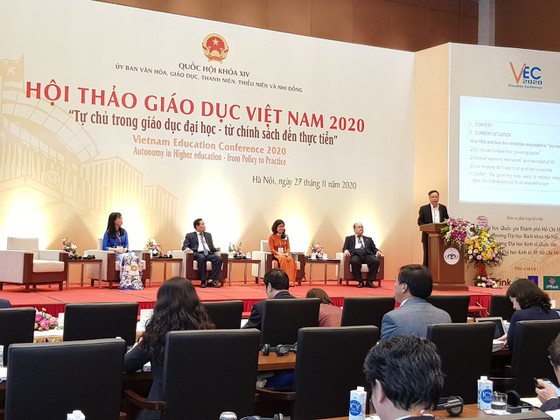 Society
Society


|
| The Việt Nam Education Conference 2020 focuses on autonomy in higher education. Photo sggp.org.vn |
HÀ NỘI - Autonomy in higher education in Việt Nam is facing challenges, particularly accountability and finances, according to Deputy Minister of Education and Training Hoàng Minh Sơn.
Speaking at the annual event Việt Nam Education Conference, Sơn said that since 2014, 23 universities in Việt Nam had joined a pilot programme on autonomy under a Government resolution.
Most of the participating universities have made breakthroughs in their training and research, which helped improve the performance of national higher education, he said.
For example, the universities had attracted more lecturers with PhD degrees, enrolled more students, launched more training programmes and the number of their studies published in international academic scientific journals increased 10 times, accounting for 45 per cent of the country’s total internationally-published studies.
Under the autonomy programme, the universities reported their revenue and spending increased 1.5 times compared with when they received more State-funding. The funding provided by the Government to them reduced 2.1 times in the last six years.
However, Sơn said during the pilot programme on university autonomy, shortcomings were revealed as the universities had unsustainable finances, with tuition fees still accounting for a high proportion of their revenue at about 80 per cent, while earnings from research activities were modest and funding from Government had reduced sharply.
Christophe Lemiere, Human Development Programme Manager of the World Bank in Việt Nam, said despite the fact that Việt Nam’s higher education had been improving, its quality was still lower than those of other ASEAN countries.
After graduating, many students in Việt Nam still lacked skills in management or technology, failing to meet the requirements of employers.
Research in higher education in Việt Nam was still modest, he said, adding that three ministries – Education and Training, Labour, Sciences and Technologies – were involved in higher education but they had not co-operated with each other effectively.
In the pilot programme on autonomy in higher education, the connection between enterprises and universities was not clear, Lemiere said.
He suggested that when universities were given autonomy, they must be accountable, particularly for ensuring training quality.
In addition, Việt Nam should increase funding for higher education to about 0.8 per cent of GDP instead of the current rate of 0.23 per cent.
Việt Nam spent up to 20 per cent of GDP on education but higher education received only 0.23 per cent, he said, adding that the rate was too modest.
A big problem for Việt Nam’s higher education was that its revenue heavily depended on tuition fees, he said, calling for more scholarships for disadvantaged students, more loans for students to attend universities and more investment in higher education.
Vice Chairwoman of the National Assembly Tòng Thị Phóng said Việt Nam had kept improving its legal framework on higher education to help it develop.
“Many policies have been developed and implemented to enhance autonomy in higher education,” she said, adding that gaps between policies and practise remained.
“The gaps and challenges drive us to change and innovate higher education,” she said, adding that improving the effectiveness of autonomy aimed to make use of universities’ strengths and then, increase training quality as well as human resource quality. VNS




